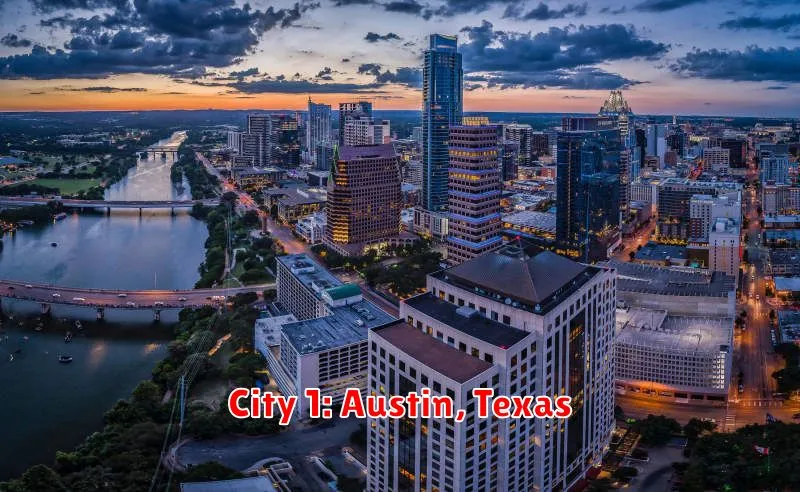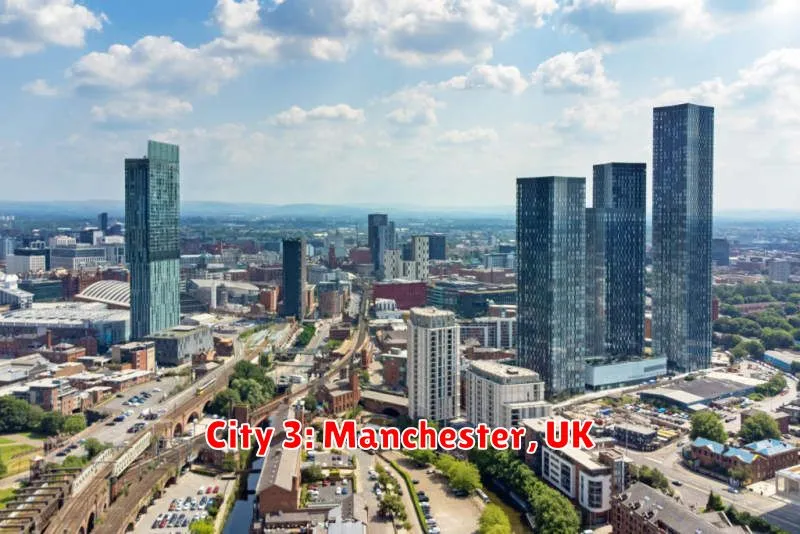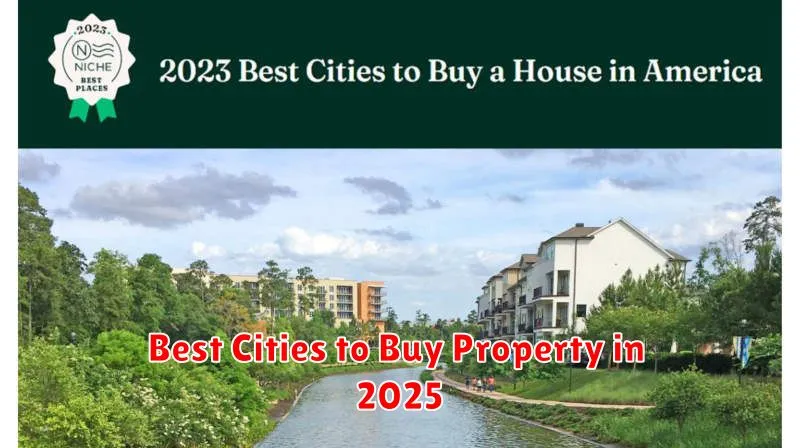Investing in real estate can be a lucrative venture, and choosing the right location is paramount to success. Are you looking to make a strategic property investment in 2025? Identifying the best cities to buy property requires careful consideration of market trends, economic growth, and future potential. This article explores some of the most promising cities for property investment in 2025, offering insights into the best places to buy property for maximizing returns and long-term value appreciation. Whether you’re a seasoned investor or a first-time buyer, understanding market dynamics is key to making informed decisions and securing a profitable future in real estate. Discover the top cities for real estate investment in 2025 and position yourself for success in the ever-evolving property market.
From burgeoning tech hubs to revitalized urban centers, the best cities for property investment in 2025 offer a diverse range of opportunities. This comprehensive guide will delve into the key factors driving growth in these top cities for real estate investment, including job market prospects, infrastructure development, and quality of life considerations. By analyzing these crucial elements, we aim to provide you with the necessary tools to pinpoint the best places to buy property and capitalize on the potential for substantial returns in 2025. Whether your investment strategy focuses on residential, commercial, or rental properties, understanding the nuances of each market is essential. Explore the best cities to buy property and unlock the potential for a secure and prosperous investment future.
What Makes a City Ideal for Investment?
Several key factors contribute to a city’s attractiveness for investment. Economic stability is paramount, indicated by consistent GDP growth, diverse industries, and low unemployment rates. A business-friendly environment characterized by streamlined regulations, transparent governance, and access to skilled labor is also crucial. Furthermore, infrastructure plays a vital role. Investors look for efficient transportation networks, reliable utilities, and robust technological infrastructure to support business operations and growth.
Beyond economic fundamentals, quality of life factors are increasingly important. A city’s appeal to skilled workers influences investment decisions. This includes access to quality education, healthcare, cultural amenities, and a safe and vibrant community. Market access also holds significant weight. A well-connected location, whether by air, sea, or land, facilitates trade and distribution, expanding market reach for businesses operating within the city.
Finally, future potential is a critical consideration for long-term investments. This encompasses factors such as projected population growth, planned developments, and the city’s capacity to adapt to technological advancements and changing market dynamics. Cities demonstrating proactive planning and a commitment to sustainable growth are generally more appealing to investors seeking both stability and future returns.
Factors Like Job Growth and Economy
Job growth and the overall economy are intrinsically linked. A strong economy typically leads to increased business activity, which in turn fuels demand for labor and drives job creation. This positive feedback loop strengthens the economy further as employed individuals contribute through spending and investment. Conversely, a weak economy often results in businesses scaling back operations or closing, leading to job losses and reduced consumer spending, thereby exacerbating economic decline.
Several key economic indicators, beyond job growth, help gauge the health of an economy. These include Gross Domestic Product (GDP), which measures the total value of goods and services produced; the inflation rate, which reflects changes in the overall price level; and consumer confidence, which measures consumer optimism about the economy. Monitoring these indicators can provide valuable insights into the current and future state of the economy.
Understanding the relationship between job growth and the economy is crucial for policymakers, businesses, and individuals. Policymakers can implement fiscal and monetary policies to stimulate economic growth and job creation. Businesses can use this understanding to make informed decisions about hiring, investment, and expansion. Individuals can benefit by understanding how economic trends may impact their job prospects and financial well-being.
City 1: Austin, Texas

Austin, the capital of Texas, is a vibrant city known for its thriving tech industry, live music scene, and outdoor recreation opportunities. The city boasts a young and educated population, contributing to a dynamic and innovative atmosphere. Major employers include companies like Tesla, Dell, and Apple, further solidifying Austin’s status as a tech hub.
The city’s cultural scene is equally impressive, with numerous live music venues showcasing diverse genres, earning Austin the title of “Live Music Capital of the World.” From indie rock to country and blues, there’s something for every music lover. Outdoor enthusiasts can enjoy the numerous parks, lakes, and hiking trails throughout the city, providing ample opportunities for kayaking, swimming, and exploring nature.
Austin’s cost of living, while increasing, remains relatively affordable compared to other major tech hubs. This, combined with the city’s appealing lifestyle and job market, makes it a desirable location for young professionals and families alike. However, the rapid growth has led to increased traffic congestion and housing costs, posing challenges for the city’s future development.
City 2: Calgary, Canada
Calgary, located in the province of Alberta, is a major Canadian city situated at the confluence of the Bow and Elbow Rivers. Known for its vibrant economy driven by the energy sector, Calgary boasts a diverse population and a relatively young demographic. The city’s proximity to the Canadian Rockies provides stunning scenery and access to world-class outdoor recreational activities. Calgary also enjoys a sunny climate, experiencing more sunshine hours annually than most Canadian cities.
As a major business hub, Calgary offers numerous employment opportunities across various industries, including finance, technology, and tourism. The city’s strong economic foundation fosters a high quality of life, with excellent infrastructure, healthcare, and education systems. Cultural attractions abound, from museums and art galleries to music venues and festivals, ensuring a rich and dynamic urban experience.
Calgary is renowned for its western heritage, famously hosting the Calgary Stampede, a large annual rodeo and exhibition. The city’s commitment to sustainability is evident in its numerous parks and green spaces, promoting a healthy and active lifestyle for its residents. Calgary’s blend of economic prosperity, natural beauty, and cultural vibrancy makes it a highly desirable place to live and work.
City 3: Manchester, UK

Manchester is a major city located in northwest England with a rich industrial heritage. Cottonopolis, as it was once known, played a pivotal role in the Industrial Revolution. Today, Manchester is a vibrant, multicultural hub known for its thriving music scene, football clubs, and universities.
The city boasts impressive architecture, blending historic Victorian structures with modern developments. Key attractions include the John Rylands Library, the Manchester Museum, and the Science and Industry Museum. Sports fans flock to Old Trafford, home of Manchester United, and the Etihad Stadium, home of Manchester City.
Manchester also offers a diverse culinary scene, vibrant nightlife, and extensive shopping options. The city’s Northern Quarter is known for its independent shops, cafes, and bars, while the Spinningfields district offers upscale dining and entertainment.
City 4: Brisbane, Australia
Brisbane, the capital of Queensland, Australia, is a vibrant and growing city known for its subtropical climate and laid-back atmosphere. Situated along the Brisbane River, the city boasts a mix of modern and historic architecture, offering a variety of cultural experiences, outdoor activities, and dining options. Visitors can enjoy riverside walks, explore its many parks and gardens, or visit cultural institutions like the Queensland Art Gallery and Gallery of Modern Art.
Brisbane’s economy is diverse and strong, with key industries including tourism, resources, and education. The city is also a popular destination for international students, contributing to its multicultural and cosmopolitan feel. Brisbane has excellent public transport, making it easy to navigate and explore different areas, from the bustling central business district to the more relaxed suburban neighborhoods.
Brisbane has hosted several major international events, showcasing its ability to welcome visitors on a large scale. The city is known for its friendly locals and a relaxed pace of life, making it an appealing destination for both tourists and those considering relocation. The future looks bright for Brisbane, with ongoing developments aimed at further enhancing its liveability and strengthening its position as a leading city in the Asia-Pacific region.
Cost of Living vs Property Value
Cost of living and property value are intertwined but distinct concepts. Cost of living refers to the overall expense of maintaining a certain standard of living in a particular location. This includes necessities like housing, food, transportation, healthcare, and taxes. Property value, on the other hand, represents the estimated market worth of a specific piece of real estate, such as a house or condo. A high cost of living doesn’t always correlate with high property values, and vice versa.
Several factors influence both cost of living and property value, but their impact can vary. For example, a strong local economy with high-paying jobs can drive up both. However, factors like limited housing supply can inflate property values while leaving wages stagnant, leading to a high cost of living despite relatively moderate incomes. Other factors include access to amenities, desirable schools, low crime rates, and the overall desirability of the location.
Understanding the relationship between these two factors is crucial for anyone looking to relocate or invest in real estate. A low cost of living paired with appreciating property values can represent an attractive opportunity. Conversely, a high cost of living coupled with stagnant or declining property values could be a red flag. Careful research and analysis are essential for informed decision-making.
Upcoming Developments in These Areas
Several key areas are poised for significant advancements. Artificial intelligence is expected to see breakthroughs in natural language processing and computer vision, leading to more sophisticated virtual assistants and enhanced automation capabilities. The biotechnology sector anticipates progress in gene editing and personalized medicine, offering potential cures for previously untreatable diseases. Finally, renewable energy technologies, such as solar and wind power, are projected to become more efficient and cost-effective, driving a transition towards sustainable energy sources.
These developments are driven by a convergence of factors. Increased investment in research and development, coupled with rapid technological innovation, is accelerating progress. Furthermore, growing consumer demand for advanced technologies and sustainable solutions is creating a market pull for these innovations.
The anticipated impact of these developments is substantial. They are expected to transform industries, create new economic opportunities, and improve the quality of life for people around the world. However, addressing potential ethical considerations and ensuring equitable access to these advancements will be crucial for maximizing their positive impact.
Transportation and Infrastructure Growth
Transportation and infrastructure are crucial for economic development and societal progress. Efficient transportation networks facilitate the movement of goods and people, connecting businesses to markets and individuals to opportunities. Furthermore, robust infrastructure, including roads, bridges, railways, ports, and airports, supports trade, tourism, and overall economic activity. Investments in these areas can lead to increased productivity, job creation, and improved quality of life.
Sustainable infrastructure development is increasingly important. This involves considering the environmental impact of projects, prioritizing energy efficiency, and minimizing carbon emissions. Incorporating smart technologies, such as intelligent transportation systems and data analytics, can optimize traffic flow, reduce congestion, and enhance safety. Focusing on resilience is also key, ensuring that infrastructure can withstand natural disasters and other disruptions.
Public-private partnerships are often essential for financing large-scale infrastructure projects. These collaborations can leverage the expertise and resources of both the public and private sectors to deliver complex projects effectively. Careful planning, transparent procurement processes, and robust regulatory frameworks are crucial for ensuring the success of these partnerships and maximizing the benefits for the community.
Property Appreciation Forecast
Predicting property appreciation is a complex undertaking influenced by numerous factors. Location remains a primary driver, with areas experiencing strong economic growth, population influx, and infrastructure development generally seeing higher appreciation. Other key factors include interest rates, housing inventory, and overall economic conditions. Analyzing these factors alongside historical trends can offer insights, though no forecast is guaranteed.
Current market conditions play a significant role in near-term forecasts. For instance, a period of rising interest rates can dampen demand, potentially slowing or even reversing appreciation. Conversely, limited housing supply coupled with strong demand can create upward pressure on prices. Local market dynamics, such as zoning regulations and new construction activity, further contribute to the complexity of forecasting.
It’s important to remember that real estate investment carries inherent risks. While historical data and market analysis can inform decisions, unforeseen events can significantly impact property values. Consulting with a qualified real estate professional can provide valuable insights tailored to specific market conditions and individual investment goals.

